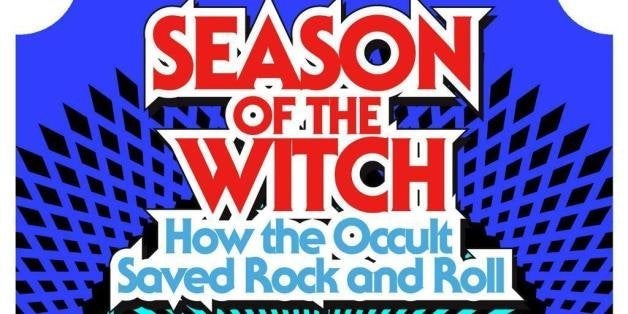
The following post is excerpted from Season of the Witch: How the Occult Saved Rock and Roll (by Peter Bebergal, with permission from Tarcher/Penguin Random House, Peter Bebergal, 2014). The book is the author's "love letter to popular music by way of the mystery at the heart of rock; a spirit that imbued the music with its own mythology replete with stories of gods, spirits, devils, and magic."
***
Sitting at a party strumming his guitar, the Scottish troubadour Donovan came upon a riff that seemed to hypnotize him. He played it over and over again and was told later he worked on it for seven hours. This riff was to become "Season of the Witch," a dark and prophetic song suggesting the new age dawning brings with it darkness. Something about it stuck. (Since then, the song has been covered by dozens of artists, including Robert Plant and Joan Jett.) "Season of the Witch" was a departure from the other songs on Donovan's 1966 album Sunshine Superman, whose titular opener begins, "Sunshine came softly a-through my a-window today." But "Season of the Witch" was oracular in another way. Something dark was coming for Donovan. The same year, Donovan was arrested for possession of cannabis, and while he wasn't much of a drug user, the British press used him as the poster child to further exploit the middle-class fear that the counterculture was rife with amoral drug fiends.
In interviews with the press, Donovan was nothing like the rock stars who were his peers. He continually pushed back against making any political statements, scandal couldn't stick to him, and he preferred to talk about keeping a neighborly fox away from his chickens. "The fox is a friend, too, but I'll have to have a chat with him," he told the Los Angeles Times in 1968. Like they did with many rock musicians, the fans and the media were looking to him to say something about the world, about the future of things. By this time, audiences were looking for wisdom, and it seemed rock musicians, by virtue of being incarnations of Bacchic energy, must also have spiritual wisdom. There was obvious power in their music, the way it shaped culture, the way the youth had followed it liked a pied piper toward drugs, sex, and other excessive rebellions. But Donovan wasn't having any of it. Donovan grew up among Gaelic mythology and legend, and his music drew from other influences ranging from Bob Dylan to Eastern ragas with which he crafted whimsical and psychedelic pop. Sunshine Superman is a walk through a fantastical landscape of wizards, Arthurian legend, jewels and gemstones, and princesses. But "Season of the Witch" became an anthem, and in an interview decades later, Donovan described the song as "ritualistic." Donovan eagerly jumped into the portal the 1960s had opened into Wonderland. There he had permission to explore musically the idea that divinity was not predisposed to exist only in heaven, but was part of the very fabric of the world. It expressed itself through myth as well as nature. This is pantheism, where God can be found in every tree and flower, every note of every song, every stoned romp in the bed of a lover. It is also pagan, where the world is animated by spirits, where nature is a book that tells the secret story of the world. Of his iconic song, Donovan said, "Maybe it is the first kind of Celtic-rock thing I was doing, a rediscovery of our roots in Britain, which of course became the British sound."
The New Forest of southern England is a protected expanse of woods, once used as a source of lumber as early as the seventeenth century, and long before then, a sacred place to ancient people who left behind burial mounds, called barrows. It is here a supposed horned deity cult of pre-Christian worshippers passed down their rituals and practices since before Christianity came to dominate Western Europe.
In 1939, Gerald Gardner, a retired anthropologist with a personal interest in the occult, met and was initiated into a coven who gathered in the thick of the forest. The story of Gardner is fraught with rumor and controversy, but it is likely at some point around 1936, he did encounter a group of people claiming to be witches. Indeed Gardner was deeply influenced by Margaret Murray and her thesis that claimed before Christianity (and until the witch trials of the Middle Ages) there was a centralized witch cult that worshipped a horned god by way of various rites and observances. Gardner believed that aspects of this cult survived in modern-day England. Gardner wanted to go "public" with what had been for generations secreted away. Fearful of British intolerance, Gardner's first book was presented as a novel called High Magic's Aid. In 1951, the Witchcraft Act, which had been in effect since 1542, was repealed and Gardner wrote two nonfiction books, Witchcraft Today and the Meaning of Witchcraft. Gardner also perpetuated Murray's idea that had largely been debunked by other scholars. Pockets of pagan worship might have existed all over Western Europe, but the notion it was ever a centralized religion that transmitted esoteric wisdom through ciphers was not widely accepted. But Gardner had enough to build his own religion.
Using what fragments he could find from those who practiced some form of pagan worship, as well as a gloss from his friend Aleister Crowley, Gardner cemented the notion of witchcraft as a religion into the popular consciousness, while alerting a burgeoning counterculture that pre-Christian spirituality was alive and well.